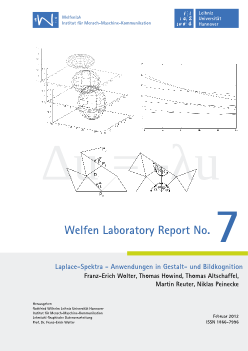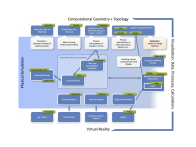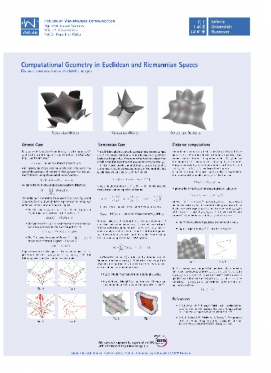Publikationen
Welfenlab Reports
Durch unsere Veröffentlichungsreihe Welfen Laboratory Reports informieren wir über Forschungsarbeiten an unserem Lehrstuhl, unter anderem werden auf diesem Weg ausgewählte studentische Abschlussarbeiten publiziert.
Publikationen nach Jahren
Hier finden sie sämtliche Publikationen des Welfenlab geordnet nach Art der Publikation und Erscheinungsdatum.
Sie finden hier auch ein vollständige Publikationsliste.
| 1979 . . . 2009 | 2010 | 2011 | 2012 | 2013 | 2014 | 2015 | 2016 |
2016
| Artikel |
| 2016 |
Benjamin Berger, Franz-Erich Wolter, Alexander Vais Colocalization structures and eigenvalue spectra for colour image comparison The Visual Computer 32. Issue 5. 9 May 2016. DOI 10.1007/s00371-016-1260-x 1-11 Springer Verlag Berlin Heidelberg 2016 Beschreibungstext anzeigen Eigenvalue spectra of the Laplace-Beltrami operator have successfully been employed as fingerprints for shape and image comparison. Especially notable in this context is the work of Peinecke on Laplace spectrum finger- printing for image data. Recently, new research on greyscale images by Berger et al. introduces the idea of attributing individual eigenfunctions to image parts and describes a mechanism for controlling their localisation. These parts are separated by sufficiently strong variations of grey value, giving the originally global fingerprint a semi-local character. This paper provides an approach to extend this idea to colour images so that not only gradients of brightness but also gradi- ents of hue or chroma lead to localisation of eigenfunctions. This is accomplished by generalising the eigenfunctions to R^2-valued functions and mapping the colours to symmetric 2×2-matrices. The resulting matrix field is then used to mod- ify the Laplacian. Finally, we present a distance function for comparing eigenvalue-based fingerprints that makes use of eigenfunction colocalization information. |
Franz-Erich Wolter Computations in Riemannian space involving geodesics with their singularities and computing and visualizing singularities of dynamical systems using numerical methods based on differential geometry (lecture at MIT, April 8, 2016) Lecture at Massachusetts Institute of Technology (MIT) 2016 Beschreibungstext anzeigen This lecture was given by Prof. F.-E. Wolter at Massachusetts Institute of Technology (MIT) on April 8, 2016. This talk will start with a brief overview on current research projects pursued at the speaker´s lab, the Welfenlab. Thereafter, the seminar will focus on two ongoing research projects. The first project deals with computations on geodesics in Riemannian manifolds with an emphasis on singular situations caused by singularities of the geodesic exponential map. In this part of the seminar, I will present computations of focal sets, geodesic joins, medial curves and geodesic Voronoi diagrams. The second project employs some insights from the first one; in this part, I will present new differential geometry-based methods for numerical computations, analysis and visualization with respect to special singularities of dynamical systems governed by differential algebraic equations. In this context, we present an apparently new technique showing that an implicitly-defined manifold can be numerically parameterized. |
Franz-Erich Wolter Computations in Riemannian space involving geodesics with their singularities and computing and visualizing singularities of dynamical systems using numerical methods based on differential geometry (lecture at University of Michigan, June 01, 2016) Lecture at University of Michigan 2016 Beschreibungstext anzeigen This lecture was given by Prof. F.-E. Wolter at University of Michigan on June 1, 2016.
More information:
|
Ricardo Manuel Millán Vaquero, Alexander Vais, Sean Dean Lynch, Jan Rzepecki, Karl-Ingo Friese, Christof Hurschler, Franz-Erich Wolter Helical Axis Data Visualization and Analysis of the Knee Joint Articulation (+video) Journal of Biomechanical Engineering 138. Issue 9. DOI: 10.1115/1.4034005 The American Society of Mechanical Engineers 2016 Beschreibungstext anzeigen We present processing methods and visualization techniques for accurately characterizing and interpreting kinematical data of flexion–extension motion of the knee joint based on helical axes. We make use of the Lie group of rigid body motions and particularly its Lie algebra for a natural representation of motion sequences. This allows to analyze and compute the finite helical axis (FHA) and instantaneous helical axis (IHA) in a unified way without redundant degrees of freedom or singularities. A polynomial fitting based on Legendre polynomials within the Lie algebra is applied to provide a smooth description of a given discrete knee motion sequence which is essential for obtaining stable instantaneous helical axes for further analysis. Moreover, this allows for an efficient overall similarity comparison across several motion sequences in order to differentiate among several cases. Our approach combines a specifically designed patient-specific three-dimensional visualization basing on the processed helical axes information and incorporating computed tomography (CT) scans for an intuitive interpretation of the axes and their geometrical relation with respect to the knee joint anatomy. In addition, in the context of the study of diseases affecting the musculoskeletal articulation, we propose to integrate the above tools into a multiscale framework for exploring related data sets distributed across multiple spatial scales. We demonstrate the utility of our methods, exemplarily processing a collection of motion sequences acquired from experimental data involving several surgery techniques. Our approach enables an accurate analysis, visualization and comparison of knee joint articulation, contributing to the evaluation and diagnosis in medical applications. |
Franz-Erich Wolter Educational lecture material "Computer Graphics II (Graphische Datenverarbeitung II)" 2016 Beschreibungstext anzeigen Educational material regarding the earlier course "Computer Graphics II (Graphische Datenverarbeitung II)", currently not being taught. |






